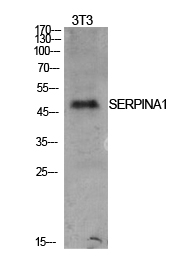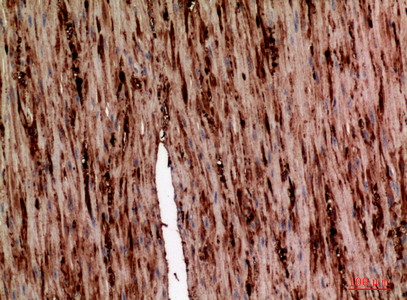AAT Polyclonal Antibody
- Catalog No.:YT5561
- Applications:WB;IHC;IF;ELISA
- Reactivity:Human;Rat
- Target:
- AAT
- Fields:
- >>Complement and coagulation cascades
- Gene Name:
- SERPINA1
- Protein Name:
- Alpha-1-antitrypsin
- Human Gene Id:
- 5265
- Human Swiss Prot No:
- P01009
- Immunogen:
- The antiserum was produced against synthesized peptide derived from the N-terminal region of human SERPINA1. AA range:1-50
- Specificity:
- AAT Polyclonal Antibody detects endogenous levels of AAT protein.
- Formulation:
- Liquid in PBS containing 50% glycerol, 0.5% BSA and 0.02% sodium azide.
- Source:
- Polyclonal, Rabbit,IgG
- Dilution:
- WB 1:500 - 1:2000. IHC: 1:100-1:300. ELISA: 1:10000.. IF 1:50-200
- Purification:
- The antibody was affinity-purified from rabbit antiserum by affinity-chromatography using epitope-specific immunogen.
- Concentration:
- 1 mg/ml
- Storage Stability:
- -15°C to -25°C/1 year(Do not lower than -25°C)
- Other Name:
- SERPINA1;AAT;PI;Alpha-1-antitrypsin;Alpha-1 protease inhibitor;Alpha-1-antiproteinase;Serpin A1
- Observed Band(KD):
- 47kD
- Background:
- The protein encoded by this gene is secreted and is a serine protease inhibitor whose targets include elastase, plasmin, thrombin, trypsin, chymotrypsin, and plasminogen activator. Defects in this gene can cause emphysema or liver disease. Several transcript variants encoding the same protein have been found for this gene. [provided by RefSeq, Jul 2008],
- Function:
- disease:Deficiency of the normal inhibitor in individuals homozygous for allele Z or M-Malton can result in the development of chronic emphysema or infantile liver cirrhosis.,disease:The major physiological function of AAT is the protection of the lower respiratory tract against proteolytic destruction by human leukocyte elastase (HLE). A hereditary deficiency of AAT, is associated with a 20-30 fold increased risk of developing chronic obstructive pulmonary disease.,disease:Variant Pittsburgh is the cause of bleeding diathesis.,domain:The reactive center loop (RCL) extends out from the body of the protein and directs binding to the target protease. The protease cleaves the serpin at the reactive site within the RCL, establishing a covalent linkage between the carboxyl group of the serpin reactive site and the serine hydroxyl of the protease. The resulting inactive serpin-protease complex
- Subcellular Location:
- Secreted. Endoplasmic reticulum. The S and Z allele are not secreted effectively and accumulate intracellularly in the endoplasmic reticulum.; [Short peptide from AAT]: Secreted, extracellular space, extracellular matrix.
- Expression:
- Ubiquitous. Expressed in leukocytes and plasma.
Polycyclic aromatic hydrocarbons are associated with increased risk of chronic obstructive pulmonary disease during haze events in China. SCIENCE OF THE TOTAL ENVIRONMENT 2016 Sep 07 WB Human 1:1000 BEAS-2B cell
Nano zerovalent iron particles induce pulmonary and cardiovascular toxicity in an in vitro human co-culture model. Nanotoxicology 2016 Feb 05 WB Human 1:1000 A549 cell
- June 19-2018
- WESTERN IMMUNOBLOTTING PROTOCOL
- June 19-2018
- IMMUNOHISTOCHEMISTRY-PARAFFIN PROTOCOL
- June 19-2018
- IMMUNOFLUORESCENCE PROTOCOL
- September 08-2020
- FLOW-CYTOMEYRT-PROTOCOL
- May 20-2022
- Cell-Based ELISA│解您多样本WB检测之困扰
- July 13-2018
- CELL-BASED-ELISA-PROTOCOL-FOR-ACETYL-PROTEIN
- July 13-2018
- CELL-BASED-ELISA-PROTOCOL-FOR-PHOSPHO-PROTEIN
- July 13-2018
- Antibody-FAQs
- Products Images

- Western Blot analysis of NIH-3T3 cells using AAT Polyclonal Antibody. Secondary antibody(catalog#:RS0002) was diluted at 1:20000

- Immunohistochemical analysis of paraffin-embedded human-colon, antibody was diluted at 1:100



